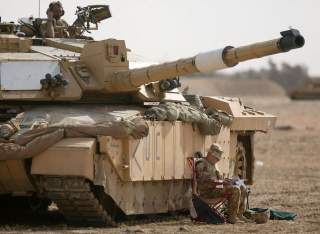Epic Fail? Expert Claims the United Kingdom's New Challenger 2 Tank Is a Terrible Mistake
Let's take a closer look.
Key point: London does make good tanks, but the Challenger 2 is missing many modern upgrades that other states possess. In fact, the U.K. has actually reduced the number of Challenger 2 tanks it intended to buy.
At least that’s the opinion of one retired army officer who during his 20-year career helped to assess tank designs on behalf of U.K. policymakers.
When the Ministry of Defense in 1987 decided to replace its existing Chieftan and Challenger I main battle tanks, according to Stuart Crawford, a regular officer in the Royal Tank Regiment, the obvious choice was Germany’s own latest tank.
“Leopard 2 was our recommendation,” Stuart wrote at U.K. Defense Journal. “And obviously we were ignored.” The other options were the American M-1A1, the French Leclerc and the British Challenger 2.
The ministry chose the Challenger 2 with its 120-millimeter rifled main gun, four-person crew and questionable automotive reliability. It perhaps shouldn’t have, Stuart wrote.
Stuart explained that he and his fellow army acquisitions officers rated the French Leclerc over the Challenger 2 “because it had an autoloader for its 120-millimeter smoothbore gun and a three-man crew. It could also fire the same ammunition as the Rheinmetall 120-millimeter smoothbore of other NATO nations.”
“However, at the time, and rightly or wrongly, it was deemed too much of a risk” owing to France’s fractious relationship with NATO.
The four-person American M-1A1 with its 120-millimeter smoothbore gun “was attractive for many of the same reasons and mounted the smoothbore gun, but we had reservations over its gas-turbine engine’s fuel requirements and the logistics implications of catering to that demand.”
“In the end the recommendation of the ... staff officers was clear,” Stuart wrote. “Britain’s next tank should ideally be the Leopard 2, mainly for reasons of reliability, impressive mobility and because of its 120-millimeter smoothbore gun, which would give Britain ammunition compatibility and interoperability with our NATO allies (many of whom opted for Leopard 2) and the perceived advantages of economy of scale of production.”
But Stuart and his colleagues appreciated the politics of the ministry’s decision. “We weren’t entirely oblivious to the furious lobbying that was going on in favor of Challenger 2 and recognised that the ‘strategic necessity’ argument for Britain to maintain its own tank design and production expertise might win the day -- even when both foreign contenders pledged to set up their production lines in the U.K.”
“A final plea that at the very least Challenger 2 should mount the 120-millimeter smoothbore fell on deaf ears. Obviously the Royal Armored Corps ended up with Challenger 2, and in fairness if has proved to be not a bad MBT even although it has never been confronted by a peer or near-peer enemy.”
The British Army ultimately bought around 900 Challenger 2s but by 2019 had reduced its fleet to just 227 tanks. Challenger 2s in 2017 took part in the British Army’s biggest European exercise in many years. Eight hundred British troops and scores of vehicles deployed to Poland and the Baltic states to train alongside troops from 16 other NATO countries.
But the Challenger 2s have suffered from a lack of upgrades. A new urban camouflage scheme that the Royal Tank Regiment in 2017 applied to a few Challenger 2s belied the vehicles’ unupgraded guns, armor and engines.
At the same time, the United States was rolling out ambitious upgrades for its M-1s while Germany and France embarked on the joint development of a brand-new tank.
The Ministry of Defense in 2019 could award a contract for the Challenger 2’s first major update in years. “Rheinmetall has offered to swap the Challenger’s 120-millimeter rifled gun for a smoothbore weapon, while the BAE-led partnership Team Challenger 2 offered to fit an active protection system,” Defense News reported.
“The army would probably like both, but given the dire state of the defense budget, affording even one of those options is problematic.”
Stuart advised the army to replace the old Challenger 2s -- and to pick a foreign design this time. “Maybe this time around the U.K. will be able to swallow its national pride and opt for the best option on offer no matter its country of provenance?”
David Axe serves as Defense Editor of the National Interest. He is the author of the graphic novels War Fix, War Is Boring and Machete Squad. This first appeared in 2019.
Image: Reuters.

